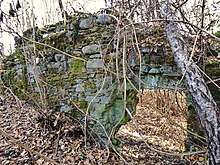Dietrichstein Castle
The castle ruins and Dietrichstein Castle are located near Feldkirchen on an important traffic route above the Glantal in Carinthia , which has been part of a main artery, the so-called Venedigerstraße between Vienna and Venice, since the Middle Ages . The castle is regarded as the ancestral seat of the important von Dietrichstein family , who eventually rose to the rank of imperial prince . The castle is a listed building .
Castle
There are traditions that the castle was built by Dietrich von Zeltschach in the 9th century. The castle was first named after a ministerial knight Dietrich, the presumed builder of the castle, from 1103. The Dietrichsteiners were originally ministerials of the Eppenstein Dukes of Carinthia, until in 1166 Hochstift Bamberg acquired the castle and the nearby town of Feldkirchen . The bishops gave the castle to a family of ministers who named themselves after the castle but did not own it.
In the coat of arms of the von Dietrichstein family there was the winegrower's knife, a reference to viticulture in the Middle Ages in this area. The facility was the security castle of the later Feldkirchen market and served to control the Glantalstrasse. Around 1335 the castle was destroyed by Margarethe Maultasch . But before 1370 the castle was restored. In 1483, Pankraz von Dietrichstein had to hand over the castle to the besieging soldiers of the Hungarian king Matthias Corvinus after six months of defense , who, contrary to the promises made at the handover, completely destroyed the castle. After the departure of the Hungarians, the castle was razed in 1491. "So to this day it remains desolate, desolate, and undeveloped, a dwelling of ghosts."
The castle complex was enthroned on a cliff above the Glan valley. Not much is left of the ruin, which was still described as “large and imposing” in the middle of the 19th century: parts of the Romanesque Bering are still preserved on the north side up to a height of around two meters. Late Gothic masonry is also visible on the east side. Until recently, the layout of the keep and the cistern could still be seen in the courtyard . On the south-west side the rock drops steeply into the Glan Valley, the north-east side is secured by two walls and three ditches.
lock
Around 1500 a small castle was built at the foot of the castle, perhaps by expanding a former farm building of the castle. It was inhabited by Erasmus Mägerl, by those of Mallentein and by the Lassachern von Weyersberg. Further changes of ownership followed (Kulmer, Mandorf, Grotta) until the building came back into the possession of the Princes von Dietrichstein in 1838 and was redesigned in the late classicist style in 1840. Since it was sold in 1932, the building has served as a residential building for a farm. The building was restored in 1972/73.
The castle is a two-story, cube-shaped building with a roof turret. On the north side is the five-axis main facade; the east and west sides have deep arched niches. The barrel vaults and stitch caps on the ground floor date back to the late Middle Ages. A Roman grave relief from the 2nd century is walled in on the ground floor.
To the west of the castle is a barn with brick lattice windows.
The Dietrichsteiner See belongs to the estate .
See also
literature
- Gerhard Stenzel: From castle to castle in Austria . Kremayr & Scheriau, Vienna 1973, ISBN 3-218-00229-X .
- Georg Clam Martinic: Austrian Castle Lexicon. Castles and ruins, mansions, palaces and palaces. 2nd Edition. Landesverlag, Linz 1992, ISBN 3-85214-559-7 .
- Michael Leischner, Alois Brandstetter: Castles and palaces in Carinthia. Carinthia, Klagenfurt 2000, ISBN 3-85378-520-4 .
- Hermann Wiessner, Gerhard Seebach: Castles and palaces in Carinthia. Wolfsberg, Friesach, St. Veit. Birken, Vienna 1977.
Web links
Individual evidence
- ^ Franz Xaver Kohla, Gustav Adolf von Metnitz, Gotbert Moro: Kärntner Burgenkunde. References to sources and literature on the historical and legal position of the castles in Carinthia and their owners. History Association for Carinthia 1973. p. 13.
- ↑ a b General Encyclopedia of Sciences and Arts. Brockhaus, Leipzig 1834. First Section, Part 25, p. 145.
- ↑ Archive for the customer of Austrian historical sources. Vienna 1854. Volume 12, p. 145.
- ^ Dehio manual. The art monuments of Austria. Carinthia . Anton Schroll, Vienna 2001, ISBN 3-7031-0712-X , p. 78.
Coordinates: 46 ° 43 '34 " N , 14 ° 7' 45" E



